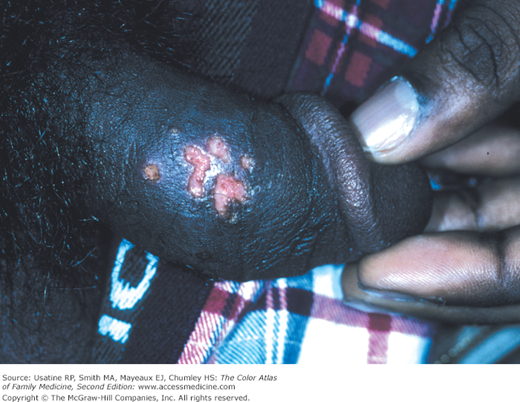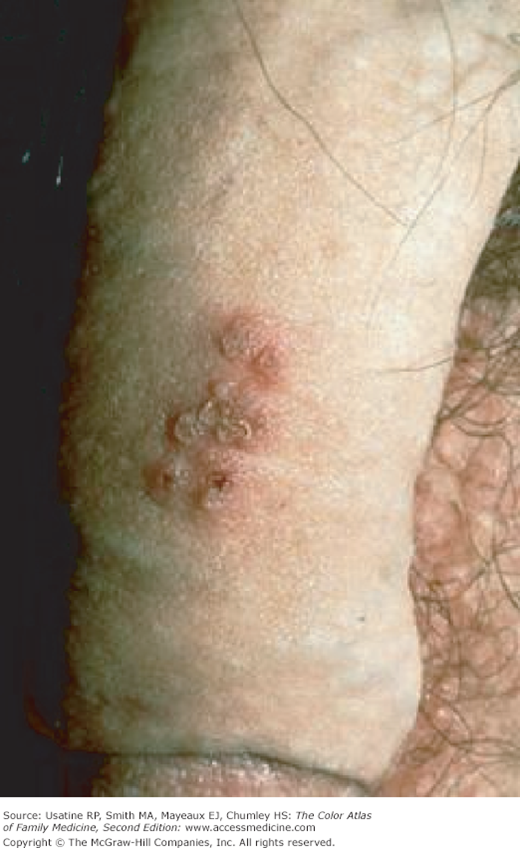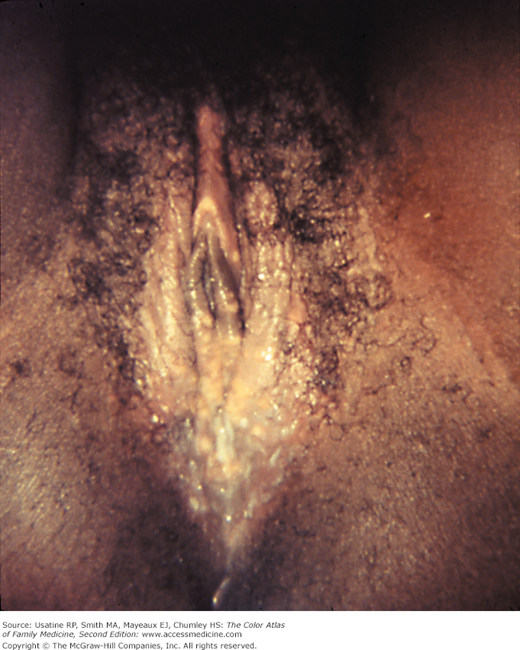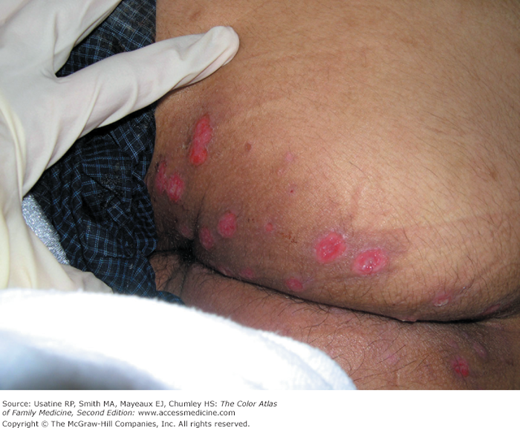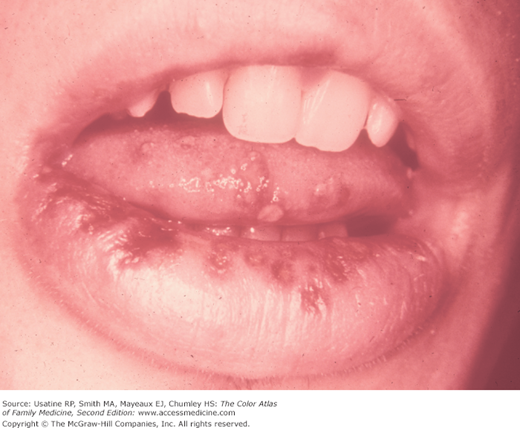Patient Story
A 32-year-old man presents with complains of a 1-week history of multiple painful vesicles on the shaft of his penis associated with tender groin adenopathy (Figure 129-1). The vesicles broke 2 days ago and the pain has increased. He had similar lesions 1 year ago but never went for healthcare examination at that time. He has had 3 different female sexual partners in the last 2 years but has no knowledge of them having any sores or diseases. He was given the presumptive diagnosis of genital herpes and a course of acyclovir. His herpes culture came back positive and his rapid plasma reagin (RPR) and HIV tests were negative.
Introduction
Epidemiology
HSV affects more than one-third of the world’s population, with the 2 most common cutaneous manifestations being genital (Figures 129-1, 129-2, 129-3, 129-4) and orolabial herpes (Figures 129-5, 129-6, 129-7).1
The Centers for Disease Control and Prevention (CDC) reports that at least 50 million persons in the United States have genital HSV-2 infection. Over the past decade, the percentage of Americans with genital herpes infection in the United States has remained stable. Most persons infected with HSV-2 have not been diagnosed with genital herpes.2
Genital HSV-2 infection is more common in women (approximately 1 out of 5 women 14 to 49 years of age) than in men (approximately 1 out of 9 men 14 to 49 years of age). Transmission from an infected male to his female partner is believed to be more likely than from an infected female to her male partner.
Orolabial herpes is the most prevalent form of herpes infection and often affects children younger than 5 years of age (Figure 129-13). The duration of the illness is 2 to 3 weeks, and oral shedding of virus may continue for as long as 23 days.1
Herpetic whitlow is an intense painful infection of the hand involving the terminal phalanx of one or more digits. In the United States, the estimated annual incidence is 2.4 cases per 100,000 persons.3
Etiology and Pathophysiology
- HSV belongs to the family Herpesviridae and is a double-stranded DNA virus.
- HSV exists as 2 separate types (types 1 and 2), which have affinities for different epithelia.3 Ninety percent of HSV-2 infections are genital, whereas 90% of those caused by HSV-1 are oral-labial.
- HSV enters through abraded skin or intact mucous membranes. Once infected, the epithelial cells die, forming vesicles and creating multinucleated giant cells.
- Retrograde transport into sensory ganglia leads to lifelong latent infection.1 Reactivation of the virus may be triggered by immunodeficiency, trauma, fever, and UV light.
- Genital HSV infection is usually transmitted through sexual contact. When it occurs in a preadolescent, the possibility of abuse must be considered.
- Evidence indicates that 21.9% of all persons in the United States, 12 years or older, have serologic evidence of HSV-2 infection, which is more commonly associated with genital infections.4
- As many as 90% of those infected are unaware that they have herpes infection and may unknowingly shed virus and transmit infection.5
- Primary genital herpes has an average incubation period of 4 days, followed by a prodrome of itching, burning, or erythema.
- With both types, systemic symptoms are common in primary disease and include fever, headache, malaise, abdominal pain, and myalgia.6 Recurrences are usually less severe and shorter in duration than the initial outbreak.1,6
- Maternal-fetal transmission of HSV is associated with significant morbidity and mortality. Manifestations of neonatal HSV include localized infection of the skin, eyes, and mouth, central nervous system (CNS) disease, or disseminated multiple organ disease (Figure 129-8). The CDC and the American College of Obstetricians and Gynecologists recommend that cesarean delivery should be offered as soon as possible to women who have active HSV lesions or, in those with a history of genital herpes, symptoms of vulvar pain or burning at the time of delivery.
- Herpetic whitlow occurs as a complication of oral or genital HSV infection and in medical personnel who have contact with oral secretions (Figures 129-9 and 129-10).
- Toddlers and preschool children are susceptible to herpetic whitlow if they have herpes labialis and engage in thumb-sucking or finger-sucking behavior.
- Like all HSV infections, herpetic whitlow usually has a primary infection, which may be followed by subsequent recurrences. The virus migrates to the peripheral ganglia and Schwann cells where it lies dormant. Recurrences observed in 20% to 50% of cases are usually milder and shorter in duration.
